Most of our perennials are listed as Alaska Grown or AKG unless otherwise labelled. AKG means these perennials have been wintered over at least one season.

Anemone multifida ‘Rubra’.
Early blooming dwarf windflower with single deep pink flowers and gold centers that hover over downy gray-green finely cut foliage. Pretty seed heads. 12” Sun to part shade. Rock garden lover. Moist, humusy soil. AKG
Early blooming dwarf windflower with single deep pink flowers and gold centers that hover over downy gray-green finely cut foliage. Pretty seed heads. 12” Sun to part shade. Rock garden lover. Moist, humusy soil. AKG

Achillea ‘Summerwine’.
Rich deep wine red yarrow with wooly textured gray-green foliage. Good cut flower. Pairs well with lilies, delphinium, and silver shrubs. 24” tall. Full sun, good drainage. AKG
Rich deep wine red yarrow with wooly textured gray-green foliage. Good cut flower. Pairs well with lilies, delphinium, and silver shrubs. 24” tall. Full sun, good drainage. AKG
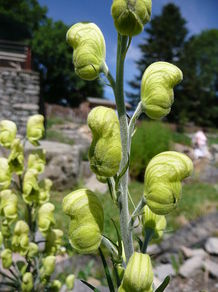
Aconitum anthora
A lovely soft yellow Monkshood from Eastern European mountain meadows. They are hard to germinate and currently I have only a handful of 2 yr. old plants available. AKG
Photo credit:
From the Jardin Botanique de l'Aubrac (http://www.aubrac-jardin.org). Liné1/CC BY-SA 2.0
A lovely soft yellow Monkshood from Eastern European mountain meadows. They are hard to germinate and currently I have only a handful of 2 yr. old plants available. AKG
Photo credit:
From the Jardin Botanique de l'Aubrac (http://www.aubrac-jardin.org). Liné1/CC BY-SA 2.0
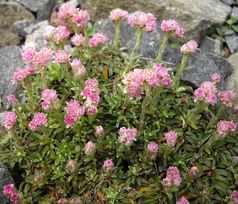
Antennaria dioica
Pink Pussytoes ! Forms low creeping soft silver mats with ‘pussytoe’ flowers on 6-8 inch stems. Nice for rock gardens and along paving stones. Very tough plant. Will self-seed. Full sun, good drainage. AKG
Pink Pussytoes ! Forms low creeping soft silver mats with ‘pussytoe’ flowers on 6-8 inch stems. Nice for rock gardens and along paving stones. Very tough plant. Will self-seed. Full sun, good drainage. AKG

Aquilegia 'McKana's Giant'
Long-spurred with large flowers, this lovely tall columbine was a favorite in grandma Alice's garden. These lovelies have been stalwarts in the old Alaskan gardens as well. With their long stems they make good cutting flowers. 20-30" tall. AKG
Long-spurred with large flowers, this lovely tall columbine was a favorite in grandma Alice's garden. These lovelies have been stalwarts in the old Alaskan gardens as well. With their long stems they make good cutting flowers. 20-30" tall. AKG
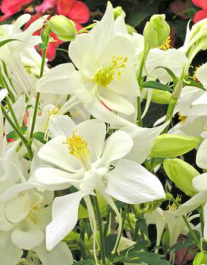
Aquilegia 'Dove'
A lovely columbine from the Songbird series. 1.5 to 2 ft. tall. AKG
A lovely columbine from the Songbird series. 1.5 to 2 ft. tall. AKG

Aquilegia 'Ruby Port' mixed
Collected from our own stocks these columbines are crosses with the original Ruby Port. We have many wonderful surprises other than these wine red lovelies and we try to separate them out by color. Sometimes we get every columbine shape there is and deep navy blue here and there. They are tough and hardy! AKG
Collected from our own stocks these columbines are crosses with the original Ruby Port. We have many wonderful surprises other than these wine red lovelies and we try to separate them out by color. Sometimes we get every columbine shape there is and deep navy blue here and there. They are tough and hardy! AKG

Campanula trachelium
Nettle-leaved bellflower is a wildflower in much of Europe. While she looks much like a stinging nettle, she is quite tame and lovely. Not to be confused with the rampant Campanula rapunculoides...you really have to look at them side by side to see the difference! AKG
Nettle-leaved bellflower is a wildflower in much of Europe. While she looks much like a stinging nettle, she is quite tame and lovely. Not to be confused with the rampant Campanula rapunculoides...you really have to look at them side by side to see the difference! AKG

Campanula 'Beetroot'
Similar in coloration and growth to 'Cherry Bells', this lovely bellflower comes from England.
They are not too tall, so, front of the border is just fine at 16 inches high. AKG
Similar in coloration and growth to 'Cherry Bells', this lovely bellflower comes from England.
They are not too tall, so, front of the border is just fine at 16 inches high. AKG
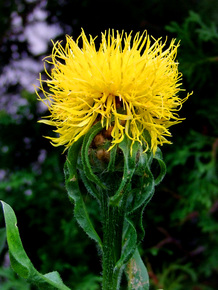
Centaurea macrocephala
Brought from the Caucasus, 1805. This magnificent plant grows to 4’, and makes a wonderful specimen, or back-of-border plant. Great golden thistle heads of bloom appear in late July. For arctic gardeners this is one of those great plants that give us our “dried” winter flower garden! Able to withstand most of the winter’s wind they are well above the snow line and add texture and interest to the endless white in the garden! Excellent for cut dried flowers. A knockout in the summer and winter when placed next to Sweet Williams, Jacob’s Ladder, and Delphiniums. Sun. Z2 - 9. AKG
Photo credit:
Au parc botanique de Meise en août 2004 by Jeantosti/ CC BY-SA 3.0
Brought from the Caucasus, 1805. This magnificent plant grows to 4’, and makes a wonderful specimen, or back-of-border plant. Great golden thistle heads of bloom appear in late July. For arctic gardeners this is one of those great plants that give us our “dried” winter flower garden! Able to withstand most of the winter’s wind they are well above the snow line and add texture and interest to the endless white in the garden! Excellent for cut dried flowers. A knockout in the summer and winter when placed next to Sweet Williams, Jacob’s Ladder, and Delphiniums. Sun. Z2 - 9. AKG
Photo credit:
Au parc botanique de Meise en août 2004 by Jeantosti/ CC BY-SA 3.0
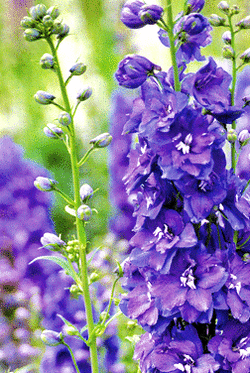
Delphinium 'Guardian Blue'
A lovely introduction with shorter stature for those daunted by towering Pacific Giants! At 3-4 ft. this slightly bi-colored blue will give loads of flowering stems for fabulous cut flower displays. Full sun to part sun for these to bloom well. Remember, all delphiniums and their cousins, Monkshood/Aconitum, are heavy feeders and appreciate the extra attention of composted beds! AKG
A lovely introduction with shorter stature for those daunted by towering Pacific Giants! At 3-4 ft. this slightly bi-colored blue will give loads of flowering stems for fabulous cut flower displays. Full sun to part sun for these to bloom well. Remember, all delphiniums and their cousins, Monkshood/Aconitum, are heavy feeders and appreciate the extra attention of composted beds! AKG

Delphinium 'Galahad'
A true Pacific Giant from the Roundtable series, this lovely fellow will tower at 6-7ft. Be sure to stake early as the bloom buds will be heavy if it rains! AKG
A true Pacific Giant from the Roundtable series, this lovely fellow will tower at 6-7ft. Be sure to stake early as the bloom buds will be heavy if it rains! AKG
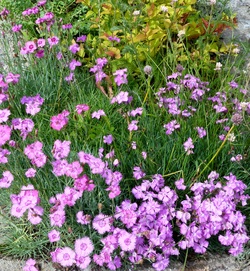
Dianthus gratianopolitanus - Alpine Pinks.
Rock garden dianthus with glaucus blue matting foliage and pink flowers. These rock hardy lovelies will grow anywhere! They smell like cloves, but, you'll have to get down on your knees to smell them! 12” x 6”high. Sun. Good drainage. Origin – Alps. AKG
Rock garden dianthus with glaucus blue matting foliage and pink flowers. These rock hardy lovelies will grow anywhere! They smell like cloves, but, you'll have to get down on your knees to smell them! 12” x 6”high. Sun. Good drainage. Origin – Alps. AKG
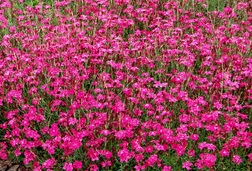
Dianthus deltoides 'Brilliancy'
A lovely spreading pink with bright green foliage. Great for flowing over rock walls and along paths. AKG
A lovely spreading pink with bright green foliage. Great for flowing over rock walls and along paths. AKG
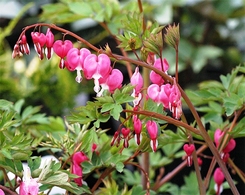
Dicentra spectabilis
Bleeding Hearts have lovely arching stems with pink heart-shaped flowers in late spring-early summer. Pick off spent flowers to prevent seed set and you will enjoy a longer bloom period. Full sun to part shade. Moist, humusy soil, well-drained. Do not plant under drip line or may freeze out! Beautiful foliage. 30 “ x 30”.
Bleeding Hearts have lovely arching stems with pink heart-shaped flowers in late spring-early summer. Pick off spent flowers to prevent seed set and you will enjoy a longer bloom period. Full sun to part shade. Moist, humusy soil, well-drained. Do not plant under drip line or may freeze out! Beautiful foliage. 30 “ x 30”.
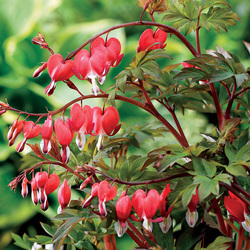
Dicentra spectabilis 'Valentine' ® ('Hordival' PP22739 COPF)
A classic Bleeding Heart with deep flushed new growth and reddish flower stems dripping with red and white hearts. For those of you who prefer less pink, this one's for you!
A classic Bleeding Heart with deep flushed new growth and reddish flower stems dripping with red and white hearts. For those of you who prefer less pink, this one's for you!
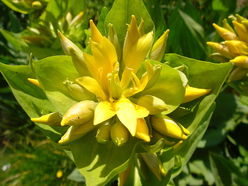
Gentiana lutea
Giant yellow gentian grows to almost 3 ft. tall. A European mountain meadow perennial, it is often used to make bitters in herbal medicine and for culinary use - the principle ingredient in Angostura bitters. However, it is likely better to enjoy looking at it unless you're an expert herbalist! These are 2 yr. seedlings. This variety has a long tap root and wants a rich, moist, deep soil with good drainage - like a mountain meadow. It will not like being transplanted once it settles in. AKG
Photo credit: Gentiana lutea by Ghislain118 http://www.fleurs-des-montagnes.net /CC BY-SA 1.0
Giant yellow gentian grows to almost 3 ft. tall. A European mountain meadow perennial, it is often used to make bitters in herbal medicine and for culinary use - the principle ingredient in Angostura bitters. However, it is likely better to enjoy looking at it unless you're an expert herbalist! These are 2 yr. seedlings. This variety has a long tap root and wants a rich, moist, deep soil with good drainage - like a mountain meadow. It will not like being transplanted once it settles in. AKG
Photo credit: Gentiana lutea by Ghislain118 http://www.fleurs-des-montagnes.net /CC BY-SA 1.0

Gentiana asclepiadea
Willow Gentian is a lovely late-blooming variety with cascades of flowers on the stems. Give them part sun to some shade with moist, peaty, acidic soil. Like its yellow cousin they have deep roots so plant them where you can resist transplanting them and you'll be rewarded in the long run. An excellent article on the Gentian family by Todd Boland can be found at: http://davesgarden.com/guides/articles/view/827/#ixzz2zsLtJqgy
Photo credit: Gentiana asclepiadea, Botanical Garden KIT, Karlsruhe, Germany. by H. Zell, 2009/CC BY-SA 3.0
Willow Gentian is a lovely late-blooming variety with cascades of flowers on the stems. Give them part sun to some shade with moist, peaty, acidic soil. Like its yellow cousin they have deep roots so plant them where you can resist transplanting them and you'll be rewarded in the long run. An excellent article on the Gentian family by Todd Boland can be found at: http://davesgarden.com/guides/articles/view/827/#ixzz2zsLtJqgy
Photo credit: Gentiana asclepiadea, Botanical Garden KIT, Karlsruhe, Germany. by H. Zell, 2009/CC BY-SA 3.0
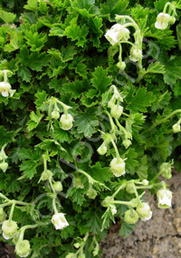
Geum rivale 'album'
Water Avens, Chocolate Root, this is an old northern European stream side spring wild flower. The delicate nodding blooms give way to seed heads that look like prickly balls. A pretty, low growing clumper, she'll like full sun to part sun and moist, but, not soggy ground. For the home brew history buff, the roots of this plant were used by the early Scandinavians in flavoring their ale before hops became available. AKG
Water Avens, Chocolate Root, this is an old northern European stream side spring wild flower. The delicate nodding blooms give way to seed heads that look like prickly balls. A pretty, low growing clumper, she'll like full sun to part sun and moist, but, not soggy ground. For the home brew history buff, the roots of this plant were used by the early Scandinavians in flavoring their ale before hops became available. AKG

Lamium maculatum
Spotted deadnettle is a cast iron ground cover that blooms from spring up to fall down! Ours are the mutts from the fancy 'Anne Greenaway' from the English Cotswolds. Yes, the offspring revert to the plain Janes. But, they are much hardier and will be with you forever! Full sun to part shade, regular garden soil, it loves to be watered, but, will take some abuse. AKG
Photo credit:
Akureyri Botanical Gardens, 2009 by Hedwig Storch/CC BY-SA 3.0
Spotted deadnettle is a cast iron ground cover that blooms from spring up to fall down! Ours are the mutts from the fancy 'Anne Greenaway' from the English Cotswolds. Yes, the offspring revert to the plain Janes. But, they are much hardier and will be with you forever! Full sun to part shade, regular garden soil, it loves to be watered, but, will take some abuse. AKG
Photo credit:
Akureyri Botanical Gardens, 2009 by Hedwig Storch/CC BY-SA 3.0
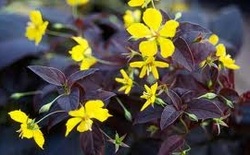
Lysimachia ciliata 'purpurea'
Yes, this is the same family as Creeping Jenny. An upright cousin with deep chocolate wine foliage and bright yellow flowers, this moisture loving perennial looks fabulous among ferns, floating above lime green foliage like Hosta Sum and Substance. Can be used as a cut flower/foliar element. Full sun to part sun, moist. AKG
Yes, this is the same family as Creeping Jenny. An upright cousin with deep chocolate wine foliage and bright yellow flowers, this moisture loving perennial looks fabulous among ferns, floating above lime green foliage like Hosta Sum and Substance. Can be used as a cut flower/foliar element. Full sun to part sun, moist. AKG
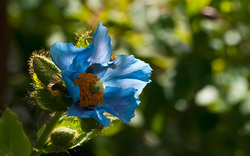
Meconopsis betonicifolia
No, it's not actually a poppy, but, it's blue and looks just like a poppy. Neighbor, Kay Sawyer, of the Blue Poppy, grows these lovelies on the back of Lazy Mountain above Wolverine Lake. She has a blue thumb! We both think these are easy perennials, but, everyone thinks they're so difficult. Give them plenty of sun, peaty and acid soil, water them regularly and mulch in the fall unless you know you'll have plenty of good snow cover. Mulch anyway....you never know! AKG
Photo credit: Axel Kristinsson from Reykjavík, Iceland/CC BY 2.0
No, it's not actually a poppy, but, it's blue and looks just like a poppy. Neighbor, Kay Sawyer, of the Blue Poppy, grows these lovelies on the back of Lazy Mountain above Wolverine Lake. She has a blue thumb! We both think these are easy perennials, but, everyone thinks they're so difficult. Give them plenty of sun, peaty and acid soil, water them regularly and mulch in the fall unless you know you'll have plenty of good snow cover. Mulch anyway....you never know! AKG
Photo credit: Axel Kristinsson from Reykjavík, Iceland/CC BY 2.0

Meconopsis Lingholm hybrid
What's the difference between these two blue beauties? This one is the taller at 28 to 36" and tends to be more 'tarp' blue in tone. Flowers seem to face a bit down as the betonicifolia can be outward facing and often a bit ruffled along the petals. This one is the classic 'blue poppy'. AKG
photo credit: by brewbooks from near Seattle, USA/CC BY-SA 2.0
What's the difference between these two blue beauties? This one is the taller at 28 to 36" and tends to be more 'tarp' blue in tone. Flowers seem to face a bit down as the betonicifolia can be outward facing and often a bit ruffled along the petals. This one is the classic 'blue poppy'. AKG
photo credit: by brewbooks from near Seattle, USA/CC BY-SA 2.0

Monarda didyma 'Raspberry Wine'
Lovely tall Bee Balm is a member of the mint family without the tendency to overstay a welcome. Loves the same rich soil conditions and full sun. Needs to be divided every other year to keep in shape though. A culinary herb, the leaves and flowers can be used for teas and as a minty oregano in cooking. As in the name, it is a bee plant. 30 inches tall. AKG
Lovely tall Bee Balm is a member of the mint family without the tendency to overstay a welcome. Loves the same rich soil conditions and full sun. Needs to be divided every other year to keep in shape though. A culinary herb, the leaves and flowers can be used for teas and as a minty oregano in cooking. As in the name, it is a bee plant. 30 inches tall. AKG
